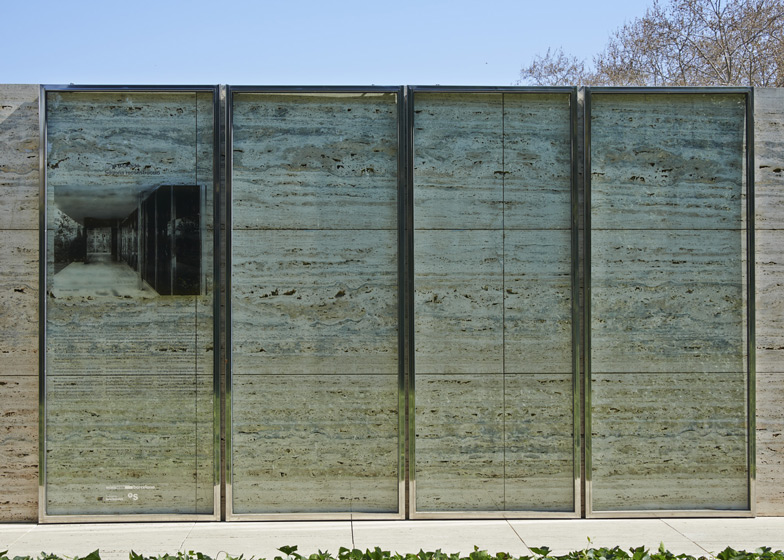Over the last few years Mies van der Rohe's Barcelona Pavilion has been loaded with junk, and had its pools filled with coffee and milk. Now photographer Jordi Bernadó has taken the doors out and mounted them onto the facade.
Spanish photographer Jordi Bernadó is the latest in a series of artists to be invited to make his mark on the iconic structure, which was first completed by Ludwig Mies van der Rohe in 1929, dismantled in 1930, then reconstructed in the 1980s.
Responding to Mies' original desire for the pavilion to be photographed before its doors were installed, Bernadó's temporary intervention, named Second Reconstruction, involved removing the two glazed entrances and positioning them in front of one of the building's travertine walls.
In this way, Bernadó says he has "restored the image" of the building. "The pavilion once again becomes, temporarily, what Mies imagined," said the photographer.
"The doors ask the question. The building without doors is the answer," he added.
The Barcelona Pavilion was reconstructed in the 1980s, using only black and white photographs as reference. Since then a number of architects, designers and artists have been invited to create a site-specific installation inside.
Last year Spanish architect Andrés Jaque filled the structure with items found in the basement, while Japanese duo SANAA installed a spiral of acrylic screens in 2009 and in 2008 Chinese artist Ai Weiwei replaced the water of the pools with milk and coffee.
Here's a description of this year's project from Jordi Bernadó:
The Pavilion. Second Reconstruction. An artistic project by Jordi Bernadó
Mies referred to the Pavilion as a "pavilion of representation". An ephemeral building whose maximum value was to represent an idea.
The aspect of the pavilion that has endured is therefore an evocation, not an object. A conceptual, not a material, act. A generator of thought, not a generator of physical space.
Consequently, what remains of the Pavilion is the idea and its images. And Mies ordered the Pavilion to be photographed without doors. In Mies's thought and view, the Pavilion had no doors.
In fact, the Pavilion existed in all its plenitude only when the doors were removed. The moment of the gaze is the only real moment.
The photographer proposes, through a minimal gesture, to restore the image of the pavilion by removing the doors. The pavilion without doors at last. At its side, doors without a building. The pavilion reconstructed at last. And the doors out of their setting, by themselves generating the question posed by the intervention. The doors ask the question. The building without doors is the answer.
Photographing is not only fabrication of images (and therefore objectual). It is above all a gaze (and therefore intellectual). The photographer gazes. And gazes, presumably and ironically, as Mies did. And curiously enough, it is thanks only to the gaze that the pavilion once again becomes, temporarily, what Mies imagined. In this way, the time factor is transformed also into a fundamental aspect of the project.
Concept, immortality, time, estrangement. Ideas with which Mies worked and which constitute the essence of the Pavilion. And which the project reclaims also. As Ms Hock said, 'gazing is inventing'.

